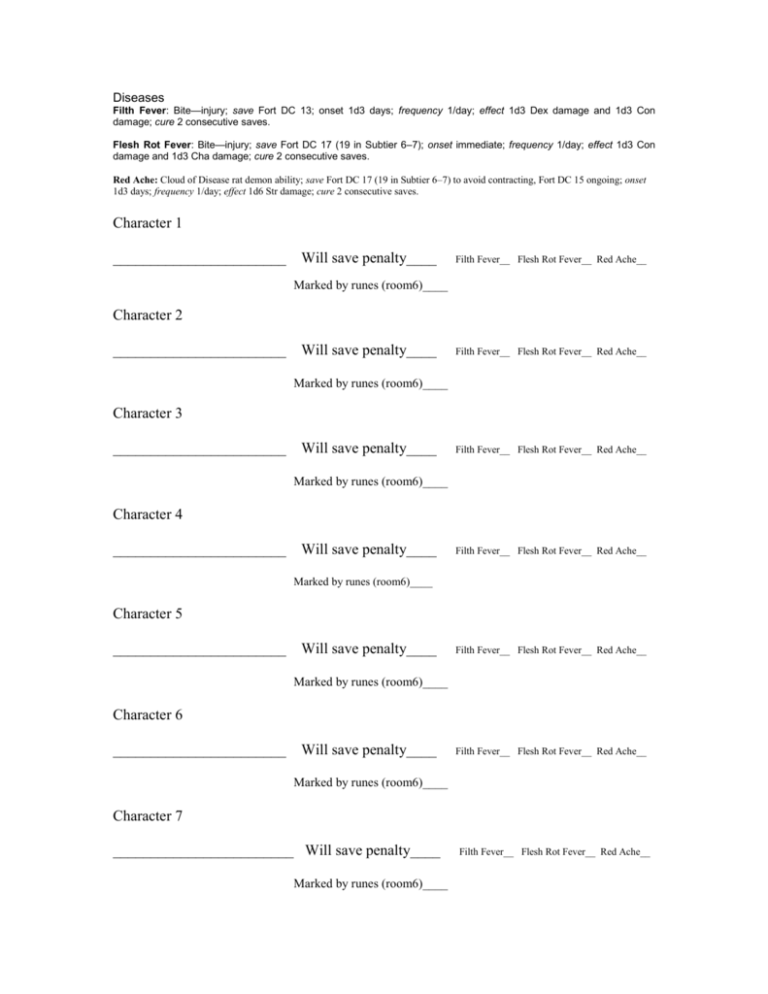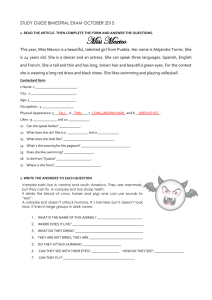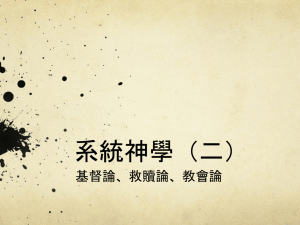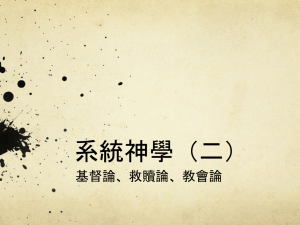Diseases
advertisement

Diseases Filth Fever: Bite—injury; save Fort DC 13; onset 1d3 days; frequency 1/day; effect 1d3 Dex damage and 1d3 Con damage; cure 2 consecutive saves. Flesh Rot Fever: Bite—injury; save Fort DC 17 (19 in Subtier 6–7); onset immediate; frequency 1/day; effect 1d3 Con damage and 1d3 Cha damage; cure 2 consecutive saves. Red Ache: Cloud of Disease rat demon ability; save Fort DC 17 (19 in Subtier 6–7) to avoid contracting, Fort DC 15 ongoing; onset 1d3 days; frequency 1/day; effect 1d6 Str damage; cure 2 consecutive saves. Character 1 _______________________ Will save penalty____ Filth Fever__ Flesh Rot Fever__ Red Ache__ Marked by runes (room6)____ Character 2 _______________________ Will save penalty____ Filth Fever__ Flesh Rot Fever__ Red Ache__ Marked by runes (room6)____ Character 3 _______________________ Will save penalty____ Filth Fever__ Flesh Rot Fever__ Red Ache__ Marked by runes (room6)____ Character 4 _______________________ Will save penalty____ Filth Fever__ Flesh Rot Fever__ Red Ache__ Marked by runes (room6)____ Character 5 _______________________ Will save penalty____ Filth Fever__ Flesh Rot Fever__ Red Ache__ Marked by runes (room6)____ Character 6 _______________________ Will save penalty____ Filth Fever__ Flesh Rot Fever__ Red Ache__ Marked by runes (room6)____ Character 7 ________________________ Will save penalty____ Marked by runes (room6)____ Filth Fever__ Flesh Rot Fever__ Red Ache__ Cave-Ins and Collapses (CR 8) Cave-ins and collapsing tunnels are extremely dangerous. Not only do dungeon explorers face the danger of being crushed by tons of falling rock, but even if they survive they might be buried beneath a pile of rubble or cut off from the only known exit. A cave-in buries anyone in the middle of the collapsing area, and then sliding debris damages anyone in the periphery of the collapse. A typical corridor subject to a cave-in might have a bury zone with a 15-foot radius and a 10-foot-wide slide zone extending beyond the bury zone. A weakened ceiling can be spotted with a DC 20 Knowledge (engineering) or DC 20 Craft (stonemasonry) check. Remember that Craft checks can be made untrained as Intelligence checks. A dwarf can make such a check if he simply passes within 10 feet of a weakened ceiling. A weakened ceiling might collapse when subjected to a major impact or concussion. A character can cause a cave in by destroying half the pillars holding up the ceiling. Characters in the bury zone of a cave-in take 8d6 points of damage, or half that amount if they make a DC 15 Reflex save. They are subsequently buried. Characters in the slide zone take 3d6 points of damage, or no damage at all if they make a DC 15 Ref lex save. Characters in the slide zone who fail their saves are buried. Characters take 1d6 points of nonlethal damage per minute while buried. If such a character falls unconscious, he must make a DC 15 Constitution check each minute. If it fails, he takes 1d6 points of lethal damage each minute until freed or dead. Characters who aren’t buried can dig out their friends. In 1 minute, using only her hands, a character can clear rocks and debris equal to five times her heavy load limit. The amount of loose stone that fills a 5-foot-by-5-foot area weighs 1 ton (2,000 pounds). Armed with an appropriate tool, such as a pick, crowbar, or shovel, a digger can clear loose stone twice as quickly as by hand. A buried character can attempt to free himself with a DC25 Strength check. Room 6 COMMAND School enchantment (compulsion) [language-dependent, mindaffecting]; Level cleric 1 Casting Time 1 standard action Components V Range close (25 ft. + 5 ft./2 levels) Target one living creature Duration 1 round Saving Throw Will negates; Spell Resistance yes You give the subject a single command, which it obeys to the best of its ability at its earliest opportunity. You may select from the following options. Approach: On its turn, the subject moves toward you as quickly and directly as possible for 1 round. The creature may do nothing but move during its turn, and it provokes attacks of opportunity for this movement as normal. Drop: On its turn, the subject drops whatever it is holding. It can’t pick up any dropped item until its next turn. Fall: On its turn, the subject falls to the ground and remains prone for 1 round. It may act normally while prone but takes any appropriate penalties. Flee: On its turn, the subject moves away from you as quickly as possible for 1 round. It may do nothing but move during its turn, and it provokes attacks of opportunity for this movement as normal. Halt: The subject stands in place for 1 round. It may not take any actions but is not considered helpless. If the subject can’t carry out your command on its next turn, the spell automatically fails. COMMAND, GREATER School enchantment (compulsion) [language-dependent, mindaffecting]; Level cleric 5 Targets one creature/level, no two of which can be more than 30 ft. apart (Haunt only targets 1 pc a round) Duration 1 round/level This spell functions like command, except that up to one creature per level may be affected, and the activities continue beyond 1 round. At the start of each commanded creature’s action after the first, it gets another Will save to attempt to break free from the spell. Each creature must receive the same command. ROOM 7 Green Slime (CR 4): This dungeon peril is a dangerous variety of normal slime. Green slime devours flesh and organic materials on contact and is even capable of dissolving metal. Bright green, wet, and sticky, it clings to walls, floors, and ceilings in patches, reproducing as it consumes organic matter. It drops from walls and ceilings when it detects movement (and possible food) below. A single 5-foot square of green slime deals 1d6 points of Constitution damage per round while it devours flesh. On the first round of contact, the slime can be scraped off a creature (destroying the scraping device), but after that it must be frozen, burned, or cut away (dealing damage to the victim as well). Anything that deals cold or fire damage, sunlight, or a remove disease spell destroys a patch of green slime. Against wood or metal, green slime deals 2d6 points of damage per round, ignoring metal’s hardness but not that of wood. It does not harm stone. Room 8 Energy Drained: The character gains one or more negative levels, which might become permanent. If the subject has at least as many negative levels as Hit Dice, he dies. See Energy Drain and Negative levels on page 562 for more information. Energy Drain and Negative Levels Some spells and a number of undead creatures have the ability to drain away life and energy; this dreadful attack results in “negative levels.” These cause a character to take a number of penalties. *For each negative level a creature has, it takes a cumulative –1 penalty on all ability checks, attack rolls, combat maneuver checks, Combat Maneuver Defense, saving throws, and skill checks. *In addition, the creature reduces its current and total hit points by 5 for each negative level it possesses. The creature is also treated as one level lower for the purpose of level-dependent variables (such as spellcasting) for each negative level possessed. *Spellcasters do not lose any prepared spells or slots as a result of negative levels. If a creature’s negative levels equal or exceed its total Hit Dice, it dies. A creature with temporary negative levels receives a new saving throw to remove the negative level each day. The DC of this save is the same as the effect that caused the negative levels. Some abilities and spells (such as raise dead) bestow permanent level drain on a creature. These are treated just like temporary negative levels, but they do not allow a new save each day to remove them. Level drain can be removed through spells like restoration. Permanent negative levels remain after a dead creature is restored to life. A creature whose permanent negative levels equal its Hit Dice cannot be brought back to life through spells like raise dead and resurrection without also receiving a restoration spell, cast the round after it is restored to life. (read raise dead for a critter with more negative levels than hit dice that hasn’t turned into an undead yet) Blood Drain (Su) A vampire can suck blood from a grappled opponent; if the vampire establishes or maintains a pin, it drains blood, dealing 1d4 points of Constitution damage. The vampire heals 5 hit points or gains 5 temporary hit points for 1 hour (up to a maximum number of temporary hit points equal to its full normal hit points) each round it drains blood. Children of the Night (Su) Once per day, a vampire can call forth 1d6+1 rat swarms, 1d4+1 bat swarms, or 2d6 wolves as a standard action. (If the base creature is not terrestrial, this power might summon other creatures of similar power.) These creatures arrive in 2d6 rounds and serve the vampire for up to 1 hour. Create Spawn (Su) A vampire can create spawn out of those it slays with blood drain or energy drain, provided that the slain creature is of the same creature type as the vampire's base creature type. The victim rises from death as a vampire spawn in 1d4 days. This vampire is under the command of the vampire that created it, and remains enslaved until its master's destruction. A vampire may have enslaved spawn totaling no more than twice its own Hit Dice; any spawn it creates that would exceed this limit become free-willed undead. A vampire may free an enslaved spawn in order to enslave a new spawn, but once freed, a vampire or vampire spawn cannot be enslaved again. Dominate (Su) A vampire can crush a humanoid opponent's will as a standard action. Anyone the vampire targets must succeed on a Will save or fall instantly under the vampire's influence, as though by a dominate person spell (caster level 12th). The ability has a range of 30 feet. At the GM's discretion, some vampires might be able to affect different creature types with this power. Energy Drain (Su) A creature hit by a vampire's slam (or other natural weapon) gains two negative levels. This ability only triggers once per round, regardless of the number of attacks a vampire makes.







